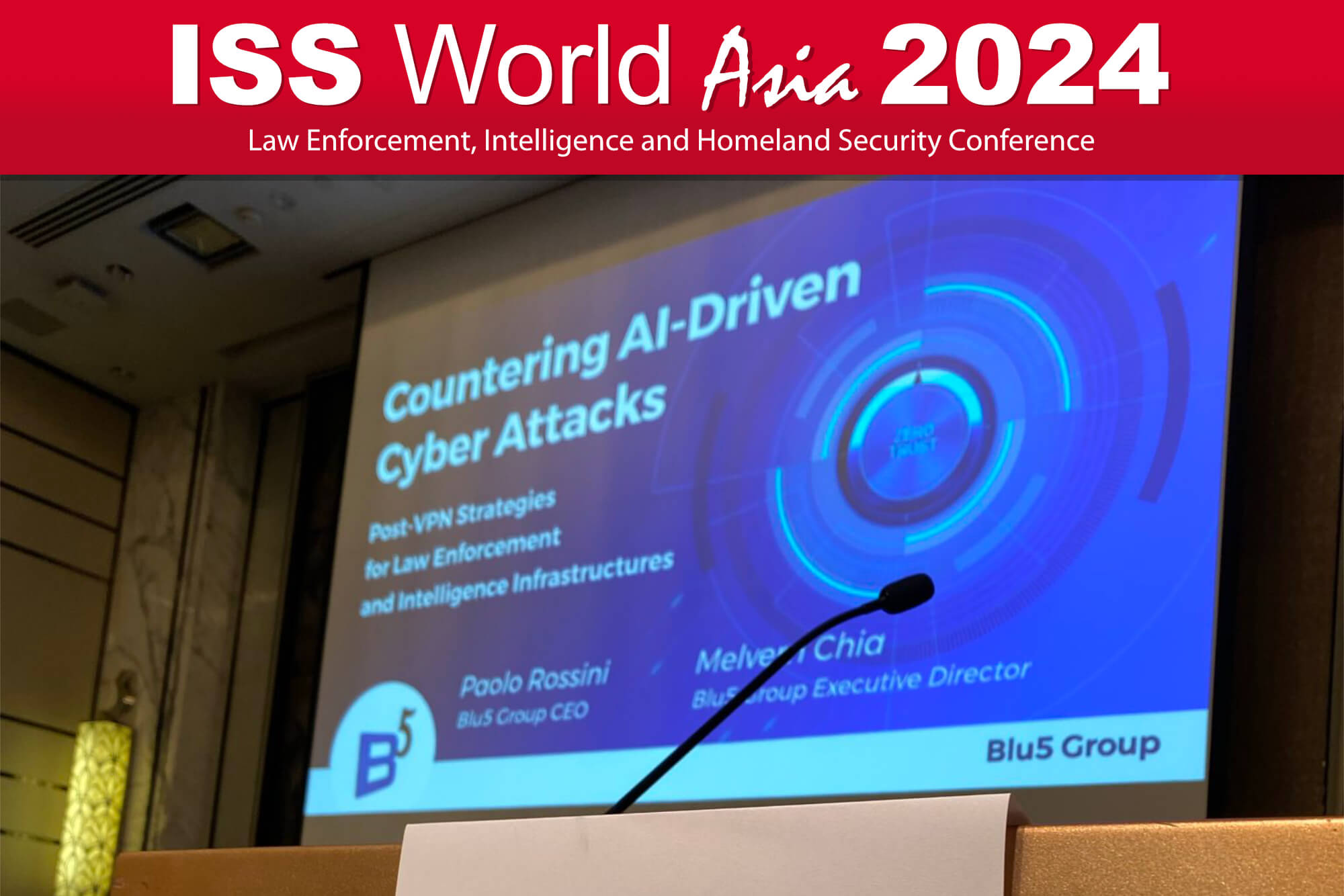ISS World Asia 2024 is a premier event focusing on intelligence gathering, analysis and law enforcement solutions in the Asia Pacific region.
September 3-5, 2024
It brought together professionals from various sectors including government, military and the private sector to discuss the latest innovations in cybersecurity, surveillance and intelligence operations. In particular, it attracted over 1,609 attendees from 75 countries and 52% were from Law Enforcement and Government Intelligence Agencies.
Blu5 Group joined ISS World Asia 2024 delivering a speech titled Countering AI-Driven Cyber Attacks: Post-VPN Strategies for Law Enforcement and Intelligence Infrastructures.
The session explored advanced strategies for countering cyber attacks, emphasising the limitations of traditional VPNs. It introduced SElink as an innovative technology enhancing security frameworks, as we discussed the evolution of Zero Trust and Network Lockdown principles in law enforcement and intelligence IT networks.
Sharing SElink as a modern solution to counter AI-driven cyberattack
SElink's approach effectively counters AI-driven cyberattacks by shifting focus from threat detection to controlling access, ensuring only authorised users gain entry. This strategy neutralises the advantages of AI attackers—such as speed, automation and adaptability—by minimizing attack surfaces and controlling access, thereby making it a robust defence strategy in the face of evolving cyber threats, not only AI-driven attacks. By shifting from a detection-centric model to one that emphasises a more sustainable and effective strategy: containment (minimizing attack surfaces) and access control. This approach provides a sustainable model for long-term cyber resilience. Instead of engaging in a futile arms race with increasingly sophisticated attacks, SElink's Zero Trust model limits the potential damage attackers can cause. The network lockdown feature adds an extra layer of defence, creating an air-gapped environment that thwarts even the most advanced AI-driven threats, enhancing the overall effectiveness of the Zero Trust approach and prioritising resilience and sustained security.
Here's how SElink's strategy aligns with countering AI-driven attacks effectively:
1. Neutralising AI-Driven Automation and Speed:
- Strict Access Controls Combined with Network Lockdown: AI-driven attacks often exploit vulnerabilities at scale and speed. SElink's strict access controls and continuous authentication mean that even if an AI-driven attack identifies a potential entry point, it will be significantly limited in what it can do. Unauthorised AI-driven bots or malware cannot access sensitive resources or move laterally across the network, regardless of their speed or sophistication. While SElink already imposes strict access controls, the network lockdown feature goes further by creating an air-gapped environment when necessary. This means that even if an AI-driven attack manages to compromise credentials or find a vulnerability, it cannot exploit open ports or network entry points because they are simply not available.
- Dynamic Adaptation: While AI attackers can adapt and learn quickly, SElink's Zero Trust model constantly verifies each access request, dynamically adjusting permissions based on real-time conditions. This makes it difficult for AI-driven attacks to exploit a single point of entry repeatedly.
- Air-Gapped Defence: AI-driven attacks often rely on finding and exploiting open network connections. The full network lockdown effectively removes these opportunities, preventing AI-driven malware from communicating with command-and-control servers, spreading, or even initiating further attacks.
2. Reducing the Effectiveness of AI in Social Engineering and Phishing:
- Granular Authorisation: Even if an AI-driven phishing attack successfully compromises credentials, SElink ensures that the compromised account has only limited access. This reduces the potential damage of such attacks, as the attackers cannot easily escalate privileges or access critical data.
- Continuous Monitoring: AI-driven attacks often rely on subtle social engineering tactics to gain deeper access over time. SElink's continuous monitoring can detect deviations from normal behaviour, flagging potential insider threats or compromised accounts before they can cause significant harm.
3. Controlling AI's Ability to Exploit and Propagate:
- Micro segmentation and network Lockdown Synergy: AI-driven attacks often aim to propagate quickly across a network once a foothold is gained. SElink's micro segmentation contains any breach to a specific segment, preventing lateral movement and significantly hindering the spread of AI-driven malware or exploits. AI-powered attackers often scan for open ports and weaknesses in exposed services. The addition of a network lockdown capability, which means that all ports to the network are closed, these AI algorithms are rendered ineffective on the target side, as they have no entry points to exploit.
- Least Privilege Access: Even if AI-driven malware infiltrates the system, the principle of least privilege ensures that the malware can only access limited resources, curbing its effectiveness. In fact, if an AI entity manages to meet all the required authorisation criteria, it could theoretically use SElink channels. However, the limited scope and mono-directional nature of these channels mean that the AI’s ability to interact with the remote infrastructure is severely constrained. The AI could still potentially cause disruptions within the limited services it accesses, but it would be unable to move laterally or exploit other services, minimizing the overall impact. Prevention of Network Reconnaissance: AI-driven attacks often perform reconnaissance to identify weak points or gather intelligence on the network. SElink effectively shuts down all ports, preventing any form of reconnaissance and leaving attackers with no information to work with.
4. Avoiding the Arms Race with AI Attackers:
- Access Over Detection: Traditional defence mechanisms might try to outpace AI-driven attacks by enhancing detection capabilities, leading to an arms race. SElink sidesteps this by focusing on strict access management. Since it doesn't rely on identifying the specific nature of each attack but rather on enforcing who can do what, it avoids the constant need to evolve detection techniques in response to new AI-driven threats.
- Resilient Architecture: By ensuring that the overall architecture is resilient, even if an AI-driven attack is successful in breaching one part of the system, SElink’s approach minimises the impact, thus countering the advantage that AI might bring to attackers.
5. Countering AI's Ability to Learn and Adapt:
- Continuous Policy Enforcement: AI-driven attacks can learn from their environment and adapt to avoid detection. However, SElink's continuous policy enforcement and real-time adaptive controls make it difficult for AI to successfully learn and bypass defences. The lack of static, predictable patterns in how access is granted means that attackers cannot easily adapt their strategies.
- Decentralised Attack Surface: By decentralising access controls and using micro-segmentation, SElink makes it harder for AI-driven attacks to gather the necessary information to adapt effectively. Each segment or resource is protected by its own set of access rules, making the system more resilient to adaptive AI attacks.
- Severing AI's Command and Control: Many AI-driven attacks depend on continuous communication with an external command-and-control server to adapt their strategies. SElink network diode function effectively sever the return channel that AI-driven attacks depend on. The diode would allow necessary data to flow into secure systems (such as logs or updates) but prevent any outbound communication from reaching the attacker's C2 server. Without this return channel, the AI's ability to adapt its attack in real-time is significantly hindered, potentially rendering the attack ineffective.



